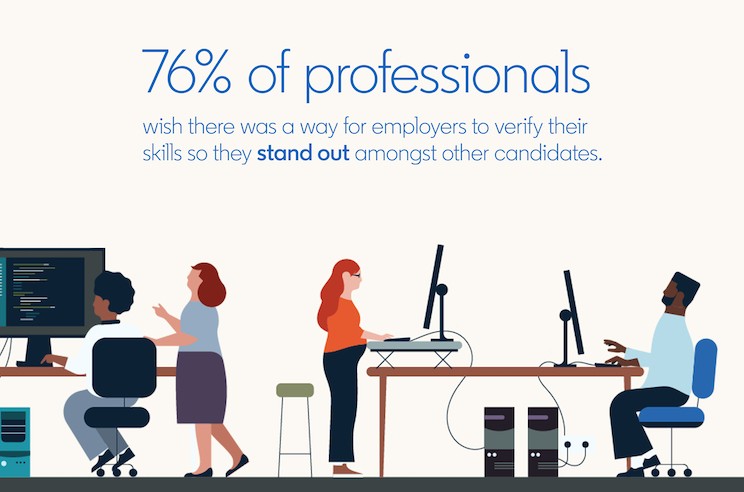We’re living in an era of innovation, disruption, and constant change. From the pandemic to the emergence of new exciting technologies to changing consumer needs and preferences, the business landscape has been on a constant rollercoaster, trying to navigate the volatility and uncertainty.
Such situations and environments demand agility and adaptability, and those that are able to deliver experience unprecedented success. This requires a strong workforce with the right skills. Unfortunately, that’s often the toughest piece of the puzzle.
Traditional hiring approaches and strategies are increasingly falling short in identifying and attracting the right talent. Candidates might have completed their education from the most prestigious universities, but still lack the practical skills required to take on niche skill roles, especially in emerging technologies. Job descriptions tend to emphasize “the wrong things”, which can screen out qualified candidates who may not have had access to high-quality education or career opportunities but still have gained relevant knowledge through multiple sources of information that the Internet now provides.
This is where skills-based hiring or competency-based hiring comes in. Skills-based hiring is a recruitment approach that takes a more holistic and comprehensive approach and prioritizes a candidate's abilities and aptitude over traditional factors like education and background.
By utilizing this route, organizations can identify and hire candidates who possess the necessary competencies to excel in a particular role, regardless of other factors. To clarify, this is not to say that degrees, a formal education, and experience are not important. The weightage it carries differs from role to role and profession to profession. The trick is to strike the right balance for the best results.
Read on as we explore why this approach is gaining traction and prominence in some of the leading companies in the world and how it is beneficial. You’ll learn how to build a high-performing team that is set for success.
Let’s dive in.
HOW SKILLS-BASED HIRING IS CHANGING THE GAME
It’s natural to be resistant to change. Several organizations and leaders push back against a suggested difference in the way they go about their regular processes as they feel it works for them and thus, does not require to be tweaked.
However, change is the only constant. As the business landscape evolves and new developments come to the forefront, what once might have seemed like the best option might no longer deliver the most desired or effective results.
The traditional hiring approach enabled a job listing that detailed the list of requirements an organization requires from potential hires, in terms of experience, educational qualifications, job titles, etc. Recruiters would then filter out the resumes based on the above-mentioned criteria, till they find someone who is the perfect fit. While this might have worked for job roles and processes that have been around for a long time, it is unlikely to continue working in a world where emerging technologies require the most talent.
Skills-based hiring takes a more nuanced and inclusive approach, assessing skills and aptitudes through multiple means. This can include skills assessments, situational testing, and performance-based interviews, which provide a more comprehensive and accurate measure of an individual's capabilities and whether or not they can take up and perform well in the position they’re applying for.
Here are some of the key benefits of skills-based hiring:
Broader Candidate Pool: This approach to recruitment allows for candidates to come to the forefront who may not have gained their expertise through esteemed universities and schools, but through non-traditional means like online courses, internships, volunteering, etc. This widens the talent pool to a great extent, making it easier to bridge the skill gap in your team and also making the organization significantly more diverse and inclusive. According to a study by Glassdoor, job seekers are 1.9 times more likely to apply to a job if they feel the employer has a diverse workforce.
Better Alignment With Job Requirements: In the rapid environment today, it’s a must that candidates be able to perform their tasks with precision, efficiency, and expertise. This can be really hard to evaluate or predict from a couple of conversations during the interview process, which is why alternative methods are rising in prominence. By bringing on board people that are sure to possess the correct skills, there is improved alignment between the employee’s performance and the organization’s expectations. This results in a pleasant work environment, elimination of micromanagement, and higher productivity. According to a study by LinkedIn, employees hired through skills-based hiring were 20% more likely to stay at the company for a year or more.
Increased Employee Engagement and Retention: When you hire people that are working not for the paycheck at the end of the month, but because they are internally driven to make a difference, they are likely to feel more fulfilled in their roles and dedicated to their tasks. This results in lower turnover rates and increased employee retention. This positive energy is also likely to rub off on the others in the team, creating a motivated workplace. According to a study by LinkedIn, employees who feel their skills are being fully utilized are 21% more likely to report high job satisfaction. Moreover, another study conducted by LinkedIn found that skills-based hiring resulted in a 30% lower risk of turnover compared to traditional hiring methods.
Reduced Recruitment Costs: Skills-based hiring can help cut down on the recruitment cost by making a larger talent pool available to the organization and reducing the need to continue pumping up salaries out of desperation for top talent. This is also beneficial in the long run. We’ve been reading about the “trend” of mass tech layoffs of late and such efficacious hiring that conserves resources is likely to help the organization tide over turbulent times without having to let their talent go. Companies can also significantly cut down on the training time and cost required by this approach. A study by IBM found that organizations that invest in skills-based hiring can reduce new hire training time by up to 50%.
Enhanced Innovation and Creativity: A more diverse workforce is bound to lead to increased innovation and problem-solving within teams. People come from different backgrounds, with varying experiences and a different approach toward situations. If organizations were to hire everyone from one particular university, it would make it very hard to access this creativity. According to a study by McKinsey & Company, companies in the top quartile for gender diversity on their executive teams were 21% more likely to experience above-average profitability than companies in the bottom quartile. Additionally, companies in the top quartile for ethnic/cultural diversity on their executive teams were 33% more likely to outperform their peers on profitability.
Improved Business Outcomes: This hardly needs an explanation. People that are internally driven and motivated are likely to perform better, giving the organization better outcomes and a significant competitive advantage in the market. According to a study by the Society for Human Resource Management, skills-based hiring can result in higher productivity, increased revenue, and decreased costs.
Better Employee Development: Skills-based hiring can also help organizations better identify areas for employee development and provide targeted training and development opportunities to enhance their skills and competencies. This can lead to higher job satisfaction, engagement, and retention. According to a study by Deloitte, companies that prioritize learning and development are 46% more likely to be leaders in their industry.
OVERCOMING CHALLENGES AND LIMITATIONS
As more and more HR industry leaders adopt the competency-based approach to recruitment, they can identify numerous advantages (those that have been mentioned above) as well as a fair share of challenges and limitations.
We’ve detailed the most prominent ones along with potential solutions, so you’re well prepared to embrace the new strategy.
Measuring Skills and Competencies
One of the most significant challenges faced with skills-based hiring is how the organization must actually define and then measure and evaluate the skills required accurately. It requires identifying the gaps within the existing team, understanding the kind of expertise that would be relevant, creating an interview process that can measure it, and then rating the candidate on several criteria. This can be difficult, especially when it comes to desirable soft skills such as communication, teamwork, responsibility, and problem-solving.
Clear and specific competency models are the solution. These models are a collection of competencies that define successful performance in a particular work setting. They must identify the skills required for a particular job and provide a structured approach to assess them- be it through written assessments, AI tools, group discussions, or more.
Identification of Transferable Skills
Transferable skills refer to those that a candidate acquires in another job setting or in another learning context and can be applied to a new role as well. Identifying these without certain criteria like a degree or years of experience can be challenging. It requires significant expertise from the recruiter as well, a thorough understanding of the job requirements, and the willingness to understand the candidate’s journey up until the present moment.
This can, again, be dealt with by adopting numerous behavioral interview questions. Narrow down on certain tricky scenarios your organization tends to face and let the candidate tell you how they’d go about resolving it. They can be explained certain projects that they’re likely to take on in that role and they can detail how they’d prepare for something like it, how much time they’d need, and what support they’d seek.
Time Intensive
The points mentioned above make it appear as if skills-based hiring can be significantly more time exhaustive. To some extent, it is true that going about recruitment in this way takes longer than the traditional route in the initial stages. However, due to the lower attrition rate and increased employee engagement, competency-based hiring actively saves you time in the long run and frees you from hiring repeatedly. Do it once but do it right.
To cut down on hiring time even more, organizations can leverage the infinite benefits of technology and online assessment tools that can screen several candidates at once to provide you with the most promising and high-potential candidates.
We’ve delved into the concept in great detail and explored some interesting benefits of competency-based hiring. We’ve also dealt with certain challenges and limitations that are bound to crop up while trying something new.
We will soon be releasing a sequel to this blog, wherein we shall delve into the specific steps that organizations can take to incorporate these methods into their recruitment process. We shall discuss, in detail, the tools and platforms that can be used to collect, analyze, and interpret data, and how this data can be used to fine-tune your hiring. We have an interesting piece lined up on the future of this approach and how they are likely to redefine the HR role in the years to come.
It is important to note that such changes and tweaks are complex and require superior expertise. As veterans in the space, we can help organizations bring on board the best talent from all around the globe that are not only highly experienced but possess the perfect medley of skills to fit right in. We excel in understanding the gaps within an organization and formulating roadmaps that help bridge them.
Reach out for more information!








 (1) (1).png)




